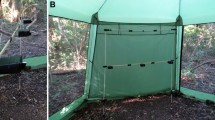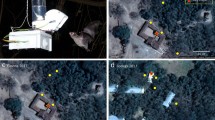Abstract
Social learning is a widespread phenomenon among vertebrates that influences various patterns of behaviour and is often reported with respect to foraging behaviour. The use of social information by foraging bats was documented in insectivorous, carnivorous and frugivorous species, but there are little data whether flower-visiting nectarivorous bats (Phyllostomidae: Glossophaginae) can acquire information about food from other individuals. In this study, we conducted an experiment with a demonstrator-observer paradigm to investigate whether flower-visiting Pallas’ long-tongued bats (Glossophaga soricina) are able to socially learn novel flower positions via observation of, or interaction with, knowledgeable conspecifics. The results demonstrate that flower-visiting G. soricina are able to use social information for the location of novel flower positions and can thereby reduce energy-costly search efforts. This social transmission is explainable as a result of local enhancement; learning bats might rely on both visual and echo-acoustical perception and are likely to eavesdrop on auditory cues that are emitted by feeding conspecifics. We additionally tested the spatial memory capacity of former demonstrator bats when retrieving a learned flower position, and the results indicate that flower-visiting bats remember a learned flower position after several weeks.



Similar content being viewed by others
References
Aisner R, Terkel J (1992) Ontogeny of pine cone opening behaviour in the black rat, Rattus rattus. Anim Behav 44:327–336
Alvarez J, Willig MR, Jones JK Jr, Webster WD (1991) Glossophaga soricina. Mamm Species 379:1–7
Barclay RMR (1982) Interindividual use of echolocation calls: eavesdropping by bats. Behav Ecol Sociobiol 10:271–275
Bonaccorso FJ (1979) Foraging and reproductive ecology in a Panamanian bat community. Bull Florida State Mus Biol Sci 24:359–408
Brunet-Rossinni AK, Wilkinson GS (2009) Methods for age estimation and the study of senescence in bats. In: Kunz T, Parsons S (eds) Ecological and behavioral methods for the study of bats. Johns Hopkins University Press, Baltimore, pp 315–326
Clarin TMA, Borissov I, Page RA, Ratcliffe JM, Siemers BM (2014) Social learning within and across species: information transfer in mouse-eared bats. Can J Zool 92:129–139
Dindo M, Whiten A, de Waal FBM (2009) Social facilitation of exploratory foraging behavior in capuchin monkeys (Cebus apella). Am J Primatol 71:419–426
Freeberg TM (2000) Culture and courtship in vertebrates: a review of social learning and transmission of courtship systems and mating patterns. Behav Processes 51:177–192
Galef BG (1975) The social transmission of acquired behavior. Biol Psychatry 10:155–160
Galef BG, Clark MM (1971) Social factors in the poison avoidance and feeding behavior of wild and domesticated rat pups. J Comp Physiol Psychol 75:341–357
Galef BG, Giraldeau L-A (2001) Social influences on foraging in vertebrates: causal mechanisms and adaptive functions. Anim Behav 61:3–15
Gaudet CL, Fenton MB (1984) Observational learning in three species of insectivorous bats (Chiroptera). Anim Behav 32:385–388
Geipel I, Kalko EKV, Wallmeyer K, Knörnschild M (2013) Postweaning maternal food provisioning in a bat with a complex hunting strategy. Anim Behav 85:1435–1441
Gillam EH (2007) Eavesdropping by bats on the feeding buzzes of conspecifics. Can J Zool 85:795–801
Griffin AS (2004) Social learning about predators: a review and prospectus. Learn Behav 32:131–140
Grüter C, Ratnieks FLW (2011) Honeybee foragers increase the use of waggle dance information when private information becomes unrewarding. Anim Behav 81:949–954
Hoppitt W, Laland KN (2013) Social learning: an introduction to mechanisms, methods and models. Princeton University Press, Princeton
Howell DJ (1974) Acoustic behavior and feeding in glossophagine bats. J Mammal 55:293–308
Kays R, Rodríguez ME, Valencia LM, Horan R, Smith AR, Ziegler C (2012) Animal visitation and pollination of flowering balsa trees (Ochroma pyramidale) in Panama. Mesoamericana 16:56–70
Knörnschild M, Nagy M, Metz M, Mayer M, von Helversen O (2010) Complex vocal imitation during ontogeny in a bat. Biol Lett 6:156–159
Leadbeater E, Chittka L (2007) The dynamics of social learning in an insect model, the bumblebee (Bombus terrestris). Behav Ecol Sociobiol 61:1789–1796
Lemke TO (1984) Foraging ecology of the long-nosed bat, Glossophaga soricina, with respect to resource availability. Ecology 65:538–548
Lemke TO (1985) Pollen carrying by the nectar-feeding bat Glossophaga soricina in a suburban environment. Biotropica 17:107–111
O’Mara MT, Dechmann DKN, Page RA (2014) Frugivorous bats evaluate the quality of social information when choosing novel foods. Behav Ecol. doi:10.1093/beheco/aru120
Page RA, Ryan MJ (2006) Social transmission of novel foraging behavior in bats: frog calls and their referents. Curr Biol 16:1201–1205
Rabenold PP (1987) Recruitment to food in black vultures: evidence for following from communal roosts. Anim Behav 35:1775–1785
Rasweiler JJ (1973) Care and management of the long-tongued bat, Glossophaga soricina (Chiroptera: Phyllostomatidae), in the laboratory, with observations on estivation induced by food deprivation. J Mammal 54:391–404
Ratcliffe JM, ter Hofstede HM (2005) Roosts as information centres: social learning of food preferences in bats. Biol Lett 1:72–74
Reader SM, Kendal JR, Laland KN (2003) Social learning of foraging sites and escape routes in wild Trinidadian guppies. Anim Behav 66:729–739
Ruczynski I, Siemers BM (2011) Hibernation does not affect memory retention in bats. Biol Lett 7:153–155
Sperr EB, Caballero-Martínez LA, Medellin RA, Tschapka M (2011) Seasonal changes in species composition, resource use and reproductive patterns within a guild of nectar-feeding bats in a west Mexican dry forest. J Trop Ecol 27:133–145
Suthers R, Chase J, Braford B (1969) Visual form discrimination by echolocating bats. Biol Bull 137:535–546
Thiele J, Winter Y (2005) Hierarchical strategy for relocating food targets in flower bats: spatial memory versus cue-directed search. Anim Behav 69:315–327
Thorpe WH (1964) Learning and instinct in animals. Methuen and Co Ltd., London
Toelch U, Stich KP, Gass Cl, Winter Y (2008) Effect of local spatial cues in small-scale orientation of flower bats. Anim Behav 75:913–920
Tschapka M, Dressler S (2002) Chiropterophily: on bat-flowers and flower-bats. Curtis’s Bot Mag 19:114–125
Tschapka M, von Helversen O (1999) Pollinators of syntopic Marcgravia species in Costa Rican lowland rain forest: bats and opossums. Plant Biol 1:382–388
Tschapka M, von Helversen O (2007) Phenology, nectar production and visitation behaviour of bats on the flowers of the bromeliad Werauhia gladioliflora in a Costa Rican lowland rain forest. J Trop Ecol 23:385–395
Van de Waal E, Claidière N, Whiten A (2013) Social learning and spread of alternative means of opening an artificial fruit in four groups of vervet monkeys. Anim Behav 85:71–76
Voelkl B, Schrauf C, Huber L (2006) Social contact influences the response of infant marmosets towards novel food. Anim Behav 72:365–372
von Helversen O (1995) Blumenfledermäuse und Fledermausblumen -Wechselbeziehungen zwischen Blüte und Bestäuber und energetische Grenzbedingungen. Rundgespräche der Kommission für Ökologie 10:217–229
von Helversen O, Winter Y (2003) Glossophagine bats and their flowers. Costs and benefits for plants and pollinators. In: Kunz T, Fenton B (eds) Bat ecology. University of Chigaco Press, Chicago, pp 346–397
Weissgerber TL, Milic NM, Winham SJ, Garovic VD (2015) Beyond bar and line graphs: time for a new data presentation paradigm. PLoS Biol 13(4):e1002128. doi:10.1371/jounal.pbio.1002128
Wilkinson GS (1995) Information transfer in bats. Symp zool Soc Lond 67:345–360
Wilkinson GS, Boughman JW (1998) Social calls coordinate foraging in greater spear-nosed bats. Anim Behav 55:337–350
Wilkinson GS, Boughman JW (1999) Social influences on foraging in bats. In: Box HO, Gibson KR (eds) Mammalian social learning: comparative and ecological perspectives. Cambridge University Press, Cambridge, pp 189–204
Winter Y, Stich KP (2005) Foraging in a complex naturalistic environment: capacity of spatial working memory in flower bats. J Exp Biol 208:539–548
Wright GS, Wilkinson GS, Moss CF (2011) Social learning of a novel foraging task by big brown bats, Eptesicus fuscus. Anim Behav. doi:10.1016/j.anbehav.2011.07.044
Zajonc R (1965) Social facilitation. Science 149:269–274
Acknowledgments
We thank Ulrike Stehle and Sebastian Zschunke for maintenance of the bat colonies, for providing technical equipment and for their general helpfulness. We thank Maria Eckenweber and Patrick Cvecko for fruitful discussions and critical comments on the manuscript. We further thank Dr. Cheng, Dr. Nachev and one anonymous reviewer for their time and helpful suggestions. This work was supported by the German Baden-Württemberg Stiftung, Eliteprogramme for Postdocs (M.K.).
Author information
Authors and Affiliations
Corresponding author
Ethics declarations
Conflict of interest
The authors have no conflict of interest to declare.
Ethical approval
All applicable international, national and institutional guidelines for the care and use of animals were followed.
Electronic supplementary material
Below is the link to the electronic supplementary material.
Supplementary material 2 (AVI 486 kb)
Supplementary material 3 (AVI 631 kb)
Supplementary material 4 (AVI 1104 kb)
Supplementary material 5 (AVI 1322 kb)
Rights and permissions
About this article
Cite this article
Rose, A., Kolar, M., Tschapka, M. et al. Learning where to feed: the use of social information in flower-visiting Pallas’ long-tongued bats (Glossophaga soricina). Anim Cogn 19, 251–262 (2016). https://doi.org/10.1007/s10071-015-0930-9
Received:
Revised:
Accepted:
Published:
Issue Date:
DOI: https://doi.org/10.1007/s10071-015-0930-9




